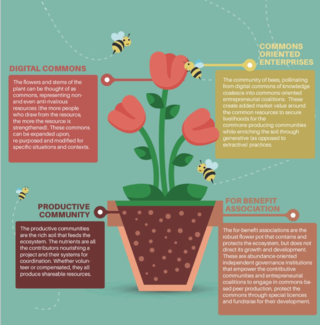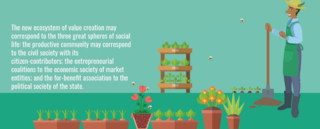Not since Marx identified Manchester’s manufacturing plants as blueprints for the new capitalist society have our political economy’s fundamentals faced a more profound transformation. As structural crises beset capitalism, a new mode of production is emerging: commons-based peer production.
Why is this emerging mode of production so important in discussions about post-capitalist futures? And how can participants in commons-based peer production— the “commoners”—make sustainable livings, thereby creating a thriving global commons economy within and beyond capitalism?
Here’s why and how.
Introduction: Two big questions
When we investigate realistic social change, it is not enough to ask (normatively) how things should be or (idealistically) how things could be. We must also look at the seeds of potential change. Just as capitalism developed over centuries by combining such patterns as double-book accounting and knowledge diffusion through printing, any post-capitalist system will be grounded in patterns emerging within capitalism or from attempts to solve its systemic problems.
These post-capitalist patterns include commons-based peer production. John Restakis (2017), David Bollier (2016), and others have addressed the re-emergence of the commons, defined as a shared resource, maintained or co-created by a community, and governed through that same community’s rules and norms. Here we go one step farther, describing an emerging mode of production that makes the commons the central feature of its value creation and distribution.
This new modality of value creation has fresh but widespread roots. It emerged in the digital realm to organize the production of open knowledge, free software, and shared designs. Now, it is also a strong candidate to take over the organization of physical production and create a political economy in which the distribution of value is both more socially just and ecologically regenerative. As we will show, forces already afoot could produce and distribute value in socially fair and environmentally balanced ways.
Commons-based peer production as a new pattern of value creation for digital production
In commons-based peer production (CBPP), originally identified as a new pathway of value creation and distribution, Internet-enabled infrastructures allow individuals to communicate, self-organize, and co-create digital commons of knowledge, software, and design (Benkler, 2006; Bauwens, 2005; Kostakis & Bauwens, 2014). Think of the free encyclopedia Wikipedia, the myriad free and open-source projects (e.g., Linux, Apache HTTP Server, Mozilla Firefox, Wordpress, Enspiral), or such open design communities as Wikihouse, RepRap, Sensorica, and Farm Hack. This remarkable new modality combines global coordination mechanisms with the small-group dynamics characteristic of human tribal forms, allowing these dynamics to go global.
Post-capitalist characteristics
CBPP differs fundamentally from value creation under industrial capitalism. In the incumbent models, the owners of the means of production hire workers, direct the work process, and sell products for profit maximization. Production is organized by allocating resources through price signals, or through hierarchical command harking to these price signals.
In contrast, CBPP is in principle open to anyone with skills to contribute to a joint project, pooling the knowledge of every participant. Some participants may be paid by companies or clients, but this system of production is also open to self-motivated contributors and distributors. In these open systems, there are many reasons to contribute beyond or besides receiving monetary payment.
CBPP allows contributions based on all kinds of motivations, but most important is the desire to create something meaningful or mutually useful to those contributing. For the productive communities as well as other users, most of their work is oriented to use-value creation, not exchange-value.
Stigmergic collaboration
In CBPP, some commoners may be paid or employed as wage labor or work for the market as freelancers. Whether paid or not, all of them produce commons. The work is not directed by corporate hierarchies, but through the mutual coordination mechanisms of the productive community. Indeed, corporate hierarchies must defer to the community values if they want to participate in this type of production. In CBPP’s open and transparent systems, everyone can see the signals of others’ work and can that way adapt to the needs of the system as a whole.
CBPP is often based on ‘stigmergic’ collaboration. Basically, stigmergy is the phenomenon of indirect communication among agents and actions (Marsh & Onof, 2007, p. 1). Think here about how ants or termites exchange information by laying down pheromones (chemical traces). This indirect form of communication enables social insects to build such complex structures as trails and nests. An action leaves a trace that stimulates the next action by the same or a different agent (ant, termite, or, in the case of CBPP, commoner).
In the context of CBPP, stigmergic collaboration is the “collective, distributed action in which social negotiation is …mediated by Internet-based technologies” (Elliott, 2006). For example, free and open-source software code lines and Wikipedia entries are all produced in a distributed and ad hoc manner as large numbers of people contribute.
Of course, unlike termites and ants, people are given to ego problems, mixed agendas, and other human frailties, so what about quality control? CBPP projects do have quality-control systems based on a hierarchy (or heterarchy). These safeguards are imperfect but improving. Without coercing work, “maintainers” in free and open source software collaboration or Wikipedia “editors,” for instance, protect the integrity of the system as a whole and can refuse contributions that endanger that integrity.
Far from the norm in traditional business, this kind of collaboration does appeal to profit-seekers, too. Since CBPP is based on more freely engaged and passionate labor and obviates some costs to capital, it can appeal to for-profit forces. Hence, we see the massive growth of CBPP in software production for industry.
A new institutional ecosystem
Through CBPP, we see a new institutional ecosystem of value creation emerging. This ecosystem consists of three institutions: the productive community, commons-oriented entrepreneurial coalition(s), and the for-benefit association. Our description cannot be all-inclusive or definitive because each ecosystem is unique and this new mode of production is rapidly evolving. The aim instead is to offer a birds-eye-view of the expanding universe of CBPP.1
| Productive Community | Linux | Mozilla | GNU | Wikipedia | Wordpress |
|---|---|---|---|---|---|
| Entrepreneurial coalition | e.g. Linus | e.g. Mozilla | e.g. Red Hat, Endless, SUSE | e.g. Wikia company | e.g. Automatic company |
| For-benefit association | Linux | Mozilla | Free Software | Wikimedia Foundation | Wordpress |
Five of the oldest and best-known commons-based peer production ecosystems.
Along with Wikipedia and the well-documented ecosystems of the free and open-source software projects, Enspiral, Sensorica, Wikihouse, and Farm Hack offer new perspectives on the rich tapestry of proliferating CBPP ecosystems. All can be described as building new post-capitalist ecosystems of value creation, and all illustrate the shift from the purely digital production of software and knowledge to its use by entities that produce physical products and sophisticated services. Enspiral has a complex service offering, including the participatory decision-making platform Loomio, Sensorica designs and deploys sensors, Wikihouse produces designs for sustainable housing, and Farm Hack engages in the participatory design of agricultural machinery. All four replay the tripartite institutional structure emblematic of digital production. A recent study of the urban commons in Ghent (Bauwens & Onzia, 2017) shows that commons-based urban provisioning systems also exemplify this new structure.
| Productive community | Enspiral | Sensorica | Wikihouse | Farmhack |
|---|---|---|---|---|
| Entrepreneurial coalition | e.g. Loomio ActionStation | e.g. Tactus Scientific Inc | e.g. Architecture 00, Momentum Engineering, Space Craft, Ltd. | e.g. Open Shops |
| For-benefit association | Enspiral Foundation | Canadian Association for the Knowledge Economy | Wikihouse Foundation | Farmhack nonprofit |
Three emerging commons-based peer production ecosystems.
The first linchpin of the new model is the productive community. It consists of all the contributors to a project of CBPP. As noted, its members may be paid or may volunteer their contributions out of sheer interest. Either way, all produce the shared resource. Most important when compared to systems based on wage labor, the system must remain open to contributions.
The second institution is the commons-oriented entrepreneurial coalition. It aims to create either profits or livelihoods by creating added value for the market, based on the shared resources. The participating enterprises can pay contributors.
The digital commons themselves are typically outside the market because they are not scarce so are not subject to the laws of supply and demand.
Crucially important in the relation among the entrepreneurs, the community, and the common-pool resource on which they depend is whether their relationship is generative or extractive. That said, every entity is expected to present a mixture.
Two distinctions are relevant here. First, entrepreneurship should not be identified exclusively with capitalism: not all entrepreneurs are motivated by profit maximization. For some, entrepreneurship expresses the desire for autonomy. In the emerging class of autonomous and precariously employed workers, many are involved in the “auto-entrepreneurship” crucial to CBPP ecosystems.
Second, markets should not be identified with capitalism. Non-capitalist market systems that are not based on wage labor or the separation of the means of production from the workers, and that operate with different “value logics” than profit maximization, have existed throughout history. They still coexist within capitalism and can be further developed as post-capitalist modalities. CBPP’s potential here is to create commons-oriented market forms that both benefit the commons and the commoners.
Crucial to the “commonification” of the entrepreneurial coalitions is the figure of the “autonomous worker.” Today’s dominant conception of the entrepreneur is of someone who is independent and takes all the risk to play the capitalist lottery. In contrast, if you want a salary, then you need to obey corporate rules. So, if you are a worker, you have a contract of subordination. In contrast, autonomous workers are free to make their own decisions and interact with the market and the commons as they wish and without permission.
This form of self-propelled enterprise should not be confused with neoliberal entrepreneurship. From a Gramscian perspective (Gramsci, 1971), CBPP can be viewed as an effort to advance alternatives to dominant ideas of what is considered “normal” and legitimate. Commons-based entrepreneurship places freedom and autonomy associated with entrepreneurship in a contributory perspective.
Consider here the creation of the labor mutual SMart, which advances the concept of “autonomous worker.” Participating workers freely engage with the market to advance their values and life projects, but mutualize their life risk through a co-owned cooperative. Such workers are ideally situated to join more commons-centric models.
Marjorie Kelly (2012) introduces non-capitalist/generative enterprises, pressing the distinction between markets and capitalism. In these enterprises, collectively owned market agents use their surplus to further social and environmental causes, rather than accumulation. To demonstrate the difference between extractive and generative economic activity, think of industrial agriculture versus permaculture. In the former, the soil grows ever poorer and less healthy while in the latter the soil becomes richer and healthier.
Extractive entrepreneurs seek to maximize their profits, and few of this breed reinvest enough in the maintenance of the productive communities. Like Facebook, they do not share any profits with the co-creating communities that provide the company’s value and its realization. Some, like Uber or Airbnb, tax exchanges without creating transport or hospitality infrastructures. So, though such enterprises develop useful services based on previously untapped resources, they do so extractively. They facilitate these services, but they also create competitive mentalities that destroy the collaborative and environmental advantages of mutualizing pooled resources. Moreover, extractive enterprises may free-ride on social or public infrastructures (e.g., roads in Uber’s case) and further undermine welfare provision by evading taxation and failing to provide social benefits.
In contrast, generative entrepreneurs add value to these communities, which they both seed and depend on. In the best case, the community of entrepreneurs and the productive community are one and the same. Creating livelihoods while producing commons, contributors re-invest the surplus in their well-being and the overall commons system they co-produce.
The third institution is the for-benefit association. This entity can be seen as the infrastructural organization of the commons that manages commons-based cooperation. Indeed, many CBPP ecosystems feature independent governance institutions that support the infrastructure for collaboration, empowering the CBPP. Cooperation thus takes place autonomously, without any command-and-control apparatus. Indeed, commoning is impossible without it. For example, the Wikimedia Foundation is the non-coercive for-benefit association of Wikipedia. Similarly, free and open-source software foundations often manage infrastructure and networks of projects.
Traditional nongovernmental and nonprofit organizations operate in a world of perceived scarcity. They spot problems, search for resources, and direct their resources toward solving the issues they have identified. This approach arguably mirrors the for-profit model of operating.
In contrast, for-benefit associations operate for ‘potential’ abundance. They recognize problems and issues but believe that there are enough contributors eager to help solve or resolve them. Hence, they maintain an infrastructure of cooperation that allows contributive communities and entrepreneurial coalitions to engage in CBPP processes vital for addressing these issues, without directly commanding the contributors. They protect these commons through licenses and may also help manage conflicts between participants and stakeholders, fundraise, and help build the general capacity needed to work in particular fields through, for example, education or certification.
The specific CBPP ecosystems are interrelated through their digital commons. Since the output of one project can be the input of another, CBPP can be seen as a grand ecosystem composed of diverse smaller ecosystems.
Overcoming the commons-capital contradictions towards an integrated economic reality
The nascent ecosystems described here are not sovereign in the current political economy, and all come with challenges and contradictions. For instance, Enspiral owes its business success largely to the distinct talent and skills of its members who are very competitive in their respective fields and who acquired skills and experiences from their education and occupations in such traditional institutions as universities, software companies, and financial firms. Beyond that, its area of expertise fills a niche in a developed market with low capital entry. Enspiral’s business model may be hard to replicate absent these factors.
Similarly, Sensorica and Farm Hack both face significant challenges concerning proper and comprehensive documentation of their processes and outputs, while WikiHouse is still striving to broaden the scope and reliability of its layouts and technologies. All the described projects, especially those entailing localized manufacturing, still rely substantially on cheap, mass-produced raw materials and components. Their business models, not yet fully defined, can sustain livelihoods for only a small number of active and highly dedicated contributors.
These caveats notwithstanding, don’t underestimate the importance of examples like those sketched here in solving urgent and neglected societal challenges. These new initiatives are gradually building considerable capacity to support this emerging commons-based political economy. Each case offers unique techno-social solutions, crystallizing a new socially embedded perception of value, defining new forms of organization and relationships to the means of production, and providing a new and more holistic representation of economic reality.
As these solutions mature and get adopted, replicated, and improved by other projects, this new economic reality could subsume and transcend today’s tumbling political order. Empowered by commoning, in time they will reshape and sublate the current contradictions and processes into a synthesized, concrete, commons-centric totality.
To be sure, the autonomous emergence and development of these seed forms are by themselves not a sufficient condition for social change. But they are a necessary feature of such change and their prefigurative function and power are vital to the success of any social change strategy. No conflict or crisis resolution can occur without reliance on these seeds of change.
From seed form to societal form
Make no mistake: the new models of production described here as an emerging institutional infrastructure at the micro level of concrete projects are also potential formats for a new post-capitalist political economy and civilization:
- The productive community at the heart of contributory value creation is also a model for a new type of civil society and for the central institution of a new post-capitalist economic and civilizational model. In this model of a productive civil society, citizens are also recognized for their contributions to society through CBPP.
- The entrepreneurial coalitions, which are generatively co-creating added value to the human and natural commons, are a model for a generative and ethical market.
- The infrastructural for-benefit associations are a model for enabling and empowering the state, which ensures the contributory equipotential capacity of its citizens and inhabitants.
Commons for the commoners, commodity for the capitalists
In CBPP, contributors create shared value through open contributory systems, govern their work through participatory practices, and create shared resources that can, in turn, be used in new iterations. This cycle of open input, participatory process, and commons-oriented output can be considered a cycle of accumulation of the commons, and this cycle parallels capital accumulation.
At this stage, CBPP prefigures what could become a post-capitalist mode of production. It is a prototype since it cannot yet fully reproduce itself outside of mutual dependence with capitalism. Productive and innovative “within capitalism,” CBPP also has the capacity to solve some of the structural problems generated by capitalism—in effect, transcending it. That said, CBPP won’t be the new “total social reality” until it also engages in physical production.
As for capitalist competition, CBPP can spur innovation. Firms that can access the digital commons possess a competitive advantage over firms that use proprietary knowledge and rely only on their research (Tapscott & Williams, 2005; Benkler 2006; von Hippel, 2017). For example, by mutualizing the software development in an open network, firms save substantially on their infrastructural investments. In this context, CBPP could be seen as a mutualization of productive knowledge by capitalist coalitions.
This capitalist investment is not negative in itself. Instead, it is a condition that has increased society’s investment in a commons-oriented transition. Since CBPP solves some structural issues of the current system, capital and both productive and managerial classes gravitate toward it. Even though prolonging the dominance of the old economic models distorts CBPP, it simultaneously sparks new ways of thinking that undermine in that dominance.
Even so, the new class of commoners cannot rely on capitalist investment and practices. Marinus Ossewaarde’s and Wessel Reijers’s (2018) threefold observation rings true here: “(1)…through technologically mediated practices of digital commoning implicit and explicit pricing mechanisms can be realised, (2)…such mechanisms draw the practices of digital commoning towards the monetary economy, (3) which in turn affects the forms of resistance that are implied in practices of digital communing.”
In the end, commoners must render CBPP more autonomous from the dominant political economy. Eventually, the balance of power could then be reversed: the commons and its social forces would become society’s dominant modality, forcing the state and market modalities to adapt to societal requirements.
Reverse cooptation
Commoners should avoid situations in which capitalists co-opt the commons and head toward situations in which the commons capture capital and use it to build its own capacity. Such reverse cooptation has been called “transvestment” by Dmytri Kleiner and Baruch Gottlieb (Kleiner, 2010, 2016). In the case of CBPPs, value would flow from the capitalist market to the commons, using generative market practices whenever possible. Thus, transvestment would help commoners become financially secure and independent. Such procedures are being developed and implemented in seed form by such open cooperatives as Sensorica or the Enspiral network.
Sensorica is a collaborative network that develops sensors. It was officially launched in 2011 in Montreal, Canada, inspired by free and open-source projects and the forms of collaboration they entailed. Sensorica explicitly separates its production processes, which are commons-based, from its market operations, which are held by independent entities though controlled by the productive network. The network’s contribution-based accounting system logs every contribution by every project participant at every stage, from initiation to marketing. In turn, all revenue from marketable products is distributed back to those who have contributed to their production. By providing livelihood opportunities, Sensorica emancipates its contributors so they can commit more of their creative energy to commons-based productive processes.
As for structure, the Enspiral network consists of the Enspiral ventures, the Enspiral Foundation, and a community of professionals representing various domains and a broad range of competencies. The Enspiral ventures offer their products and services in the market, like any common enterprise, but their focus is on the social economy, and they mobilize in response to societal challenges. Through this process, they create commons (software, infrastructures, knowledge—most famously, Loomio, a web application that helps groups make decisions together), but also revenue and (in some Enspiral ventures) even profits. A portion of these funds is donated to the Foundation. The latter then uses a part of them to cover its operation, and the rest is reinvested to new commons-based projects through democratic procedures. When projects are externally financed, the backing companies typically redeem their shares once an agreed-upon level of return has been reached. This agreement, combined with democratic control, allows the companies to decide to reinvest profits in their social mission and/or new Enspiral projects.
Open Cooperativism
Open cooperativism is a working concept aimed at infusing cooperatives with the basic principles of CBPP (Bauwens & Kostakis, 2014). Pat Conaty and David Bollier (2014) have called for “a new sort of synthesis or synergy between the emerging peer production and commons movement on the one hand, and growing, innovative elements of the co-operative and solidarity economy movements on the other.” To a higher degree than in traditional cooperatives, open cooperatives would statutorily be oriented toward the common good by co-building digital and/or material commons. This orientation basically extends the seventh cooperative principle—concern for the community (ICA, 2018). In contrast to traditional cooperatives, open cooperatives pool their digital resources (knowledge, software, designs), creating a multifaceted digital commons for other open cooperatives. So, open cooperatives would internalize negative externalities, adopt multi-stakeholder governance models, help create immaterial and material commons, and be socially and politically organized around global concerns, even if they produce locally.
One way to understand open cooperativism is to look at how the medieval guild system functioned. A guild was an association of producers who oversaw the practice of their craft or trade in a particular geographical area. It had elements of a professional association, a trade union, a cartel, and a secret society. Externally, guilds sold their goods or services in the marketplace, but internally they were fraternities and solidarity systems. In a commons-centric economy, such efficiency and solidarity could be achieved through open participatory systems that would connect producers and consumer/user communities, as community-supported agriculture does now. By this token, the models proposed below would intertwine contributors with various roles into one solidarity ecosystem.
Beyond the classical corporate paradigm
Here, six interrelated strategies for post-capitalist entrepreneurial coalitions are outlined. All aim to go beyond the classical corporate paradigm and its extractive profit-maximizing practices to establish open cooperatives that cultivate a commons-oriented economy.
First, it is essential to recognize that closed business models are based on artificial scarcity. Although knowledge in digital form can be shared quickly and at low marginal cost, traditional firms may use artificial scarcity to extract rents from its creation. Through legal repression or technological sabotage, naturally shareable goods are sometimes made artificially scarce to generate extra profits (Kostakis et al., 2018). This is particularly galling when life-saving medicines or planet-regenerating technological knowledge are overpriced or unnecessarily scarce. Open cooperatives, in comparison, would refuse to generate revenue by making such abundant resources as knowledge artificially scarce.
Second, a typical CBPP project involves various distributed tasks, to which individuals can freely contribute. For instance, in the free and open-source software projects, participants contribute code, create designs, maintain websites, translate text, co-develop the marketing strategy, and offer user support. In this setup, salaries based on a fixed job description may not be the most appropriate way to reward contributors. An alternative is open value accounting or contributory accounting: any income from contributions flows to contributors according to the points accrued from their meaningful participation in collective production. This model could be an antidote to the tendency in many firms for a handful of well-placed contributors to capture the value co-created by a much larger community.
Third, open cooperatives could secure fair distribution and benefit-sharing of commonly created value through “copyfair” licenses (Bauwens & Kostakis, 2014). Today’s “copyleft” licenses—such as Creative Commons and the GNU Public License—allow anyone to reuse the necessary knowledge commons provided that changes and improvements are subsequently shared in that same commons. The hitch is that this framework fails to encourage reciprocity for commercial use of the commons or to foster a level playing field for commons-oriented enterprises. These shortcomings can be overcome through copyfair licenses that allow for sharing while also ingraining reciprocity. More particularly, these licenses preserve the right of sharing knowledge but predicate commercialization of any such knowledge commons on contributing to that commons. For example, the copyfair approach to licensing endorses the free and open-source software freedoms enshrined in the GNU Public License, but regulates profit-making potential. The Peer Production License is the first case of copyfair that restricts the usage of a digital commons to worker cooperatives (Kleiner, 2010). Further, the FairShares Association uses a Creative Commons non-commercial license for the general public but allows its members to use the content commercially.
Fourth, open cooperatives would use open designs to produce sustainable goods and services. For-profit enterprises often build planned obsolescence into products to maintain tension between supply and demand and maximize profits. Such obsolescence is a feature, not a bug. In contrast, open design communities do not have the same incentives to plan obsolescence (Kostakis et al., 2018).
Fifth, open cooperatives could reduce waste. The lack of transparency and penchant for antagonism among closed enterprises makes it hard for them to create a circular economy in which the output of one production process becomes an input for another. However, open cooperatives could develop ecosystems of collaboration through open supply chains. These chains may enhance the transparency of production processes so participants could adapt their behavior based on the knowledge available in the network. There is no need for overproduction once the realities of the network become common knowledge. Open cooperatives could then move beyond exclusive reliance on imperfect market price signals and toward mutual coordination of production, thanks to the combination of open supply chains and open value accounting.
Sixth, open cooperatives could mutualize both digital and physical infrastructures. Despite the justified critique it receives, the misnamed “sharing economy” of Airbnb and Uber does illustrate the potential for matching idle resources. Co-working, skill sharing, and ride sharing also exemplify the many ways in which we can reuse and share resources. With co-ownership and co-governance, a genuine sharing economy could use resources far more efficiently, aided by shared data facilities and manufacturing tools.
Cooperative ownership of platforms can also begin to reorient the platform economy around a commons-oriented model. The six practices highlighted here are already emerging in various forms but need to be more universally integrated. In our estimate, the primary aim for fostering a more commons-centric economy is to recapture surplus value that is now feeding speculative capitalism and reinvest it in the development of commons-oriented productive communities. Otherwise, CBPP’s potential will remain underdeveloped and subservient to the dominant system.
The challenge of physical production and the creation of sustainable production
Typically, the need for capital is dramatically higher for physical production, which requires natural resources, buildings, machines, and people. Clearly, assembling networked individuals requires substantially less capital. Nevertheless, as noted, CBPP cannot be considered a full mode of production unless it integrates both digital and physical production.
Building on the confluence of the digital commons of knowledge, software, and design with local manufacturing technologies, new models of physical production are emerging. They can be codified as “design global, manufacture local” (DGML). What is light (knowledge, design), this logic goes, becomes global, while what is heavy (machinery) is local and ideally shared. DGML demonstrates how a technology project can leverage the digital commons to engage the global community in its development, celebrating new forms of cooperation (Kostakis et al., 2018; Kostakis et al., 2015; Kostakis et al., 2016). Unlike large-scale industrial manufacturing, the DGML model emphasizes small-scale, decentralized, resilient, and locally controlled applications. DGML could recognize the scarcities posed by finite resources and organize material activities to conserve them. After all, since manufacturing is largely local, shipping costs are lower, and maintenance is easier. Manufacturers design products to last as long as possible under the DGML mantle, and knowledge and design are freely shared since there are no patent costs.
Already, we see a rich tapestry of DGML initiatives unfolding in the global economy that do not need a unified physical basis because their members are located all over the world. For example, consider the L’Atelier Paysan (France) and Farm Hack (U.S.), communities that collaboratively build open-source agricultural machines for small-scale farming or the OpenBionics project that produces open-sourced, low-cost designs for robotic and bionic devices or the RepRap community that creates open-source designs for 3D printers.
Cities around the world are partially embracing this shift, as evidenced in a study on the urban commons (Bauwens & Onzia, 2017). In Ghent, Belgium, nearly 500 urban commons were identified, a tenfold increase in 10 years, covering all the basic provisioning systems. Most of these commons-based forms, however, redistribute but don’t produce goods. For instance, car and bike-sharing schemes mutualize access to transport but do not manufacture the vehicles. Similarly, housing coops, co-housing, and community land trusts offer access to housing but do not “make” the housing.
A further limitation: Many generative projects remain fragmented and locally limited. As welcome as these initiatives’ rapid growth is, it’s not enough to turn the tide. Public-commons cooperation must be combined locally with community wealth building policies inspired by the models in Cleveland and Preston, UK. What’s more, transnational investment coalitions are needed to create global open depositories for setting up provisioning systems and mutual learning endeavors that are locally adapted but globally coordinated.
One fast-growing sector amid a more fundamental transformation is ahead of the game. It can create healthy food for urbanites, livelihoods for producers, multi-stakeholder governance systems involving both producers and consumers, and meaningful work in an integrated ecosystem. Indeed, 80 of the 500 projects identified in Ghent were food projects—organic farmers supplying food through various commons-based schemes. Such local agricultural production exemplifies CBPP’s next stage: the cosmo-local production of goods. This stage combines open global communities mutualizing production knowledge, distributed local production, and cooperative, generative organization of the productive ecosystem. The challenge—extending this model to the economy’s more capital-intensive sectors—is likely to require the commitment of both the public sector and the world of cooperative investment and financing.
The greatest challenge, however, remains creating sustainable modes of production. Kate Raworth (2017) has very usefully summarized what needs doing: fulfill humanity’s social needs without exceeding the carrying capacity of the planet and damaging the vital cycles and needed balanced ecosystems that sustain human life.
The commons will be a vital part of this strategy for human survival. Commoning requires pooling and mutualizing resources and infrastructures to replace the wasteful corporate competition that reflects the systematic externalization of social and environmental costs to keep expenses and prices as low as possible. In contrast, CBPP’s “collaborative advantage” is that it produces products and services for human need, at lower thermodynamic costs than capitalist production models (Piques & Rizos, 2017). For example, the associate car-sharing project in Ghent, Degage, uses 130 cars for 1,300 members, guaranteeing them full mobility while greatly lowering environmental costs. Studies of similar projects have shown that every shared vehicle can replace up to 13 private cars (Shaheen, 2017).
Commoning is both green and efficient. Commons-based organic food ecosystems do not pollute the groundwater, do not use toxic additives, and can use carbon-free transportation systems. As shown in the meta-historical comparisons of civilizational overshoots (Motesharrei et al., 2014), more equal access to the resources of life significantly reduces resource catastrophes and makes crisis periods less severe. Production models that use a “subsidiarity of material production” approach will dramatically cut transportation costs and needs while maintaining global cultural and technical cooperation.
The good news is that pioneering communities all over the world are developing many of the tools needed to make this shift. For example:
- open and contributive accounting systems, able to recognize and reward all contributions, not just market value, as pioneered by Sensorica and others,
- shared ecosystemic circular supply chains, as experimented by Provenance, the Oxchain research project, eventually using the eco-systemic shared accounting systems like the R-E-A system, integrated impact and/or biophysical accounting systems, allowing direct access to thermo-dynamic flows and expenditures, using “global thresholds and allocations,”
- non-ecologically destructive distributed ledger systems, such as the Holochain,
- token-based value systems, which allow programmable production based on various value logics.
Instead of conclusions: A drinking horn for the commons
In medieval times, drinking horns were often used by guilds communally to symbolize and promote conviviality, friendship, and solidarity among the members. These values proved of great importance to the prosperity of the guild (Rosser, 2015).
Needed now is a drinking horn for the commons to help make CBPP a dominant production modality. The guild system can inspire commoners looking for sustainable livelihoods. Our transitional vision includes commons-based networks of “neo-guilds” comprised of cooperatives and autonomous producers. These networks would produce value—a global commons for the commoners and the general public and a product to be sold to enterprises outside the commons.
The small-scale initiatives can now be influential on a larger scale, as nodes in a commons-based global network of local networks. Through digital commoning, grassroots initiatives can have both a local and global orientation: “the small and the local, when they are open and connected, can therefore become a design guideline for creating resilient systems and sustainable qualities, and a positive feedback loop between these systems” (Manzini, 2013). Hence, instead of “scaling-up,” CBPP initiatives are “scaling-wide.”
With a crisis of capital accumulation upon us, might a stream of value seek and find a place in the commons economy? Yes. Instead of the cooptation of the commons economy by capital through capitalist platforms that capture value from common enterprise (e.g., Facebook, Google, IBM), commoners can coopt capital inside the commons, and subject it to its rules.
Much depends on whether we can pull off more sophisticated types of reverse cooptation. Commoners must create interconnected transvestment vehicles that admit capital disciplined by the new commons and market forms developed through CBPP. For example, “double-licensing” schemes require those who wish to capitalize to pay a license fee or join the commons-based neo-guild. This approach creates a flow of value from the system of capital to the system of the commons economy.
The ultimate vision for a new society is one of a civil society productive in its own right, not just an adjunct to the market and state. Under this new dispensation, the state enables free social production in a galaxy of interconnected, collaborative initiatives. True, CBPP does not solve many of today’s inequalities and systemic social unfairness, especially involving race and gender. Nor does it directly address the hidden environmental and social costs of digital technologies, which are energy-intensive throughout their life-cycle, from cradle to the grave. Also, low-wage laborers (often including children) work under inhumane circumstances so that ever more people in the advanced economies have access to cheap digital technologies. But these shortcomings and injustices can be addressed, and CBPP traces a unique grand institution dealing with value creation that is far removed from the catastrophic characteristics of modern capitalism. This connection to sustainability is likely to open up new spaces for a free, fair, and long-lived society.
Acknowledgments
Parts of this essay are based on the authors’ forthcoming open-access book (co-authored with Alex Pazaitis), titled Peer to Peer: The Commons Manifesto, to be published by University of Westminster Press. It also builds on Bauwens M. & Kostakis V. (2016). “Why Platform Co-ops should be Open Co-ops.” In Scholz
T. & Schneider N. (eds) Ours to Hack and Own: The Rise of Platform Cooperativism, a New Vision for the Future of Work and a Fairer Internet. New York, NY: OR Books, 163-166. Vasilis Kostakis acknowledges funding from the European Research Council (ERC) under the European Union’s Horizon 2020 research and innovation program (grant agreement No. 802512).
References
Bauwens, M. (2005). The Political Economy of Peer Production. Ctheory. Retrieved from http:// www.ctheory.net/articles.aspx?id=499 (accessed on 10 June 2018).
Bauwens, M., & Kostakis, V. (2014). From the Communism of Capital to Capital for the Commons: Towards an Open Co-operativism. tripleC: Journal for a Global Sustainable Information Society, 12(1): 356-361.
Bauwens, M., & Onzia,Y. (2017). A Commons Transition Plan for the City of Ghent . Ghent: City of Ghent and P2P Foundation. Retrieved from: https://stad.gent/sites/default/files/page/documents/Commons%20Transition%20Plan%20-%20under%20revision.pdf.
Bauwens M., Kostakis V. & Pazaitis, A. (2018) Peer to Peer: The Commons Manifesto. London. UK: University of Westminster Press. In press.
Benkler, Y. (2006). The Wealth of Networks: How Social Production Transforms Markets and Freedom. New Haven, CT: Yale University Press.
Bollier, D. (2016). Commoning as a Transformative Social Paradigm. The Next System Project. Retrieved from: https://thenextsystem.org/commoning-as-a-transformative-social-paradigm.
Conaty P. & Bollier D. (2014). Toward an Open Co-operativism: A New Social Economy Based on Open Platforms, Co-operative Models and the Commons. A Report on a Commons Strategies Group Workshop, Berlin, 27-28 August. Retrieved from http://commonstransition.org/toward-an-open-co-operativism/ (accessed on 10 June 2018).
Dafermos, G. (2012). Authority in Peer Production: The Emergence of Governance in the FreeBSD Project. Journal of Peer Production, 1 (1): 1-12.
Elliott, M. (2006). Stigmergic Collaboration:The Evolution of Group Work. M/C Journal: A Journal of Media and Culture, 9(2) . Retrieved from: http://journal.media-culture. org.au/0605/03-elliott.php (accessed on 10 June 2018).
Gramsci, A. (1971). Selections from the Prison Notebooks of Antonio Gramsci. New York, NY: International Publishers.
Harhoff, D., & Lakhani, K. (2016). Revolutionizing Innovation: Users, Communities, and Open Innovation. Cambridge, MA: MIT Press.
ICA. (2018). Co-operative Identity, Values & Principles. Available at: https://ica.coop/en/whats-co-op/co-operative-identity-values-principles (accessed 10 June 2018).
Kelly, M. (2012). Owning Our Future: The Emerging Ownership Revolution—Journeys to a Generative Economy. Oakland, CA: Berrett-Koehler Publishers.
Kleiner, D. (2010). The Telekommunist Manifesto. Amsterdam: Institute of Network Cultures.
Kleiner, D. (2016). What Economy? Profit Versus Sustainability. Available at: https://www.youtube.com/watch?v=iGBzhon_vS0&feature=youtu.be&t=36m1s.
Kostakis, V., & Bauwens, M. (2014). Network Society and Future Scenarios for a Collaborative Economy. Basingstoke, UK: Palgrave Macmillan.
Kostakis, V., Roos, A., & Bauwens, M. (2016). Towards a Political Ecology of the Digital Economy: Socio-environmental Implications of Two Value Models. Environmental Innovation and Societal Transitions, 18, 82-100.
Kostakis, V., Niaros, V., Dafermos, G., & Bauwens, M. (2015). Design Global, Manufacture Local: Exploring the Contours of an Emerging Productive Model. Futures, 73, 126-135.
Kostakis, V., Latoufis, K., Liarokapis, M., & Bauwens, M. (2018). The Convergence of Digital Commons with Local Manufacturing from a Degrowth Perspective: Two Illustrative Cases. Journal of Cleaner Production, 197, 1684-1693. Retrieved from: https://www.sciencedirect.com/science/article/pii/S0959652616314184 .
Manzini, E. (2013). Small, Local, Open and Connected: Resilient Systems and Sustainable Qualities. Design Observer. Retrieved from: https://designobserver.com/feature/small-local-open-and-connected-resilient-systems-and-sustainable-qualities/37670.
Marsh, L., & Onof, C. (2007). Stigmergic Epistemology, Stigmergic Cognition. Cognitive Systems Research, 9(1-2), 136-149.
Masters, R. (1753/2011). The History of the College of Corpus Christi and the Blessed Virgin Mary in the University of Cambridge, From its Foundation to the Present Time. Cambridge, UK: Cambridge University Press.
Mateos-Garcia, J., & Steinmueller, E. (2008). The Institutions of Open-source Software: Examining the Debian Community. Information Economics and Policy, 20: 333-344.
Motesharrei, S., Rivas, J., & Kalnay, E. (2014). Human and nature dynamics (HANDY): Modeling Inequality and Use of Resources in the Collapse or Sustainability of Societies. Ecological Economics, 101, 90-102.
Ossewaarde M. & Reijers W. (2018). Digital Commoning and its Challenges. Organization. In press.
Pazaitis A, Kostakis V. & Bauwens M. (2017). Digital Economy and the Rise of Open Cooperativism: The Case of the Enspiral Network. Transfer: European Review of Labour and Research, 23(2): 177-192.
Restakis, J. (2017). Cooperative Commonwealth & the Partner State. The Next System Project. Retrieved from https://thenextsystem.org/cooperative-commonwealth-partner-state.
Piques, C., & Rizos, X. (2017). Peer to peer and the Commons: A Matter, Energy and Thermodynamic Perspective. Amsterdam: P2P Foundation. Retrieved from: https://commonstransition.org/peer-peer-commons-matter-energy-thermodynamic-perspective/.
Raworth, K. (2017). Doughnut Economics: Seven Ways to Think Like a 21st-century Economist. Vermont: Chelsea Green Publishing.
Rosser, G. (2015). The Art of Solidarity in the Middle Ages: Guilds in England 1250-1550. Oxford: Oxford University Press.
Shaheen, S. (2017). Carsharing Trends and Research Highlights. Retrieved from https://www.epa.gov/sites/production/files/2017-06/documents/05312017-shaheen.pdf.
Tapscott D.& Williams A. (2006). Wikinomics: How Mass Collaboration Changes Everything. New York, NY: Portfolio.
von Hippel, E. (2017). Free Innovation. Cambridge, MA: MIT Press.
Weber, S. (2005). The Success of Open Source. Cambridge, MA: Harvard University Press.
All web links were active on July 6, 2018.




















- 1These ecosystems have been thoroughly discussed by several studies. See indicatively Dafermos, 2012; Harhoff & Lakhani, 2016; Mateos-Garcia & Steinmueller, 2008; Weber, 2005; Benkler, 2006; von Hippel, 2017.






